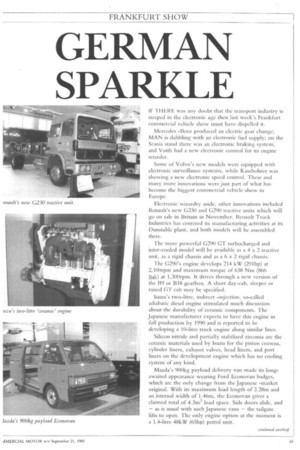GERMAN SPARKLE
Page 67

If you've noticed an error in this article please click here to report it so we can fix it.
IF THERE was any doubt that the transport industry is steeped in the electronic age then last week's Frankfurt commercial vehicle show must have dispelled it.
Mercedes -Benz produced an electric gear change; MAN is dabbling with an electronic fuel supply; on the Scania stand there was an electronic braking system; and Voith had a new electronic control for its engine retarder.
Some of Volvo's new models were equipped with electronic surveillance systems, while Kassbohrer was showing a new electronic speed control. These and many more innovations were just part of what has become the biggest commercial vehicle show in Europe.
Electronic wizardry aside, other innovations included Renault's new G230 and G290 tractive units which will go on sale in Britain in November. Renault Truck Industries has centered its manufacturing activities at its Dunstable plant, and both models will be assembled there.
The more powerful G290 GT turbocharged and inter-cooled model will be available as a 4 x 2 tractive unit, as a rigid chassis and as a 6 x 2 rigid chassis.
The G290's engine develops 214 kW (291hp) at 2,100rpm and maximum torque of 638 Nm (866 lbft) at 1,300rpm. It drives through a new version of the B9 or B18 gearbox. A short day-cab, sleeper or raised GT cab may be specified.
Isuzu's two-litre, indirect -injection, so-called adiabatic diesel engine stimulated much discussion about the durability of ceramic components. The Japanese manufacturer expects to have this engine in full production by 1990 and is reported to be developing a 10-litre truck engine along similar lines.
Silicon nitride and partially stabilised zirconia are the ceramic materials used by Isuzu for the piston crowns, cylinder liners, exhaust valves, head liners, and port liners on the development engine which has no cooling system of any kind.
Mazda's 900kg payload delivery van made its longawaited appearance wearing Ford Econovan badges, which are the only change from the Japanese -market original. With its maximum load length of 2.28m and an internal width of 1.46m, the Econovan gives a claimed total of 4.3m3 load space. Side doors slide, and — as is usual with such Japanese vans — the tailgate lifts to open. The only engine option at the moment is a 1.4-litre 48kW (65hp) petrol unit.




































































































